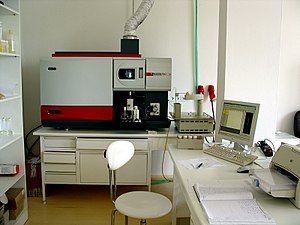Inductively coupled plasma atomic emission spectroscopy

Inductively coupled plasma atomic emission spectroscopy (ICP-AES), also referred to as inductively coupled plasma optical emission spectrometry (ICP-OES), is an analytical technique used for the detection of trace metals. It is a type of emission spectroscopy that uses the inductively coupled plasma to produce excited atoms and ions that emit electromagnetic radiation at wavelengths characteristic of a particular element.[1][2] The intensity of this emission is indicative of the concentration of the element within the sample.
Mechanism
The ICP-AES is composed of two parts: the ICP and the optical spectrometer. The ICP torch consists of 3 concentric quartz glass tube and a coil of the radio frequency (RF) generator which surrounds part of this torch. Argon gas is typically used to create the plasma.
When the torch is turned on, an intense magnetic field from the RF generator is turned on. The argon gas flowing through is ignited with a Tesla unit (typically a copper strip on the outside of the tube). The argon gas is ionized in this field and flows in a particular rotationally symmetrical pattern towards the magnetic field of the RF coil. A stable, high temperature plasma of about 7000 K is then generated as the result of the inelastic collisions created between the neutral argon atoms and the charged particles.
A peristaltic pump delivers an aqueous or organic sample into a nebulizer where it is atomized and introduced directly inside the plasma flame. The sample immediately collides with the electrons and other charged ions in the plasma and is broken down into charged ions. The various molecules break up into their respective atoms which then lose electrons and recombine repeatedly in the plasma, giving off the characteristic wavelengths of the elements involved.
A shear gas, typically nitrogen or dry compressed air is used to 'cut' the plasma flame at a specific spot. One or two transfer lenses are then used to focus the emitted light on a diffraction grating where it is separated into its component radiation in the optical spectrometer. The light intensity is then measured with a photomultiplier tube at the specific wavelength for each element line involved.
The intensity of each line is then compared to previous measured intensities of known concentrations of the element and its concentration is then computed by extrapolation along the calibration line.
Applications
Examples of the application of ICP-AES include the determination of metals in wine,[3] arsenic in food,[4] and trace elements bound to proteins.[5]
In 2008, the technique was used at Liverpool University to demonstrate that a Chi-Rho amulet found in Shepton Mallet and previously believed to be among the earliest evidence of Christianity in England,[6] only dated to the nineteenth century.[7][8][9]
See also
- Atomic emission spectroscopy
- Atomic absorption spectroscopy
- Inductively coupled plasma mass spectrometry
- Ashing
References
- ^ Stefánsson A, Gunnarsson I, Giroud N (2007). "New methods for the direct determination of dissolved inorganic, organic and total carbon in natural waters by Reagent-Free Ion Chromatography and inductively coupled plasma atomic emission spectrometry". Anal. Chim. Acta. 582 (1): 69–74. doi:10.1016/j.aca.2006.09.001. PMID 17386476.
{{cite journal}}: CS1 maint: multiple names: authors list (link) - ^ Mermet, J. M. (2005). "Is it still possible, necessary and beneficial to perform research in ICP-atomic emission spectrometry?". J. Anal. At. Spectrom. 20: 11–16. doi:10.1039/b416511j.
{{cite journal}}: Cite has empty unknown parameter:|coauthors=(help)|url=http://www.rsc.org/publishing/journals/JA/article.asp?doi=b416511j%7Cformat=%7Caccessdate=2007-08-31 - ^ Aceto M, Abollino O, Bruzzoniti MC, Mentasti E, Sarzanini C, Malandrino M (2002). "Determination of metals in wine with atomic spectroscopy (flame-AAS, GF-AAS and ICP-AES); a review". Food additives and contaminants. 19 (2): 126–33. PMID 11820494.
{{cite journal}}: CS1 maint: multiple names: authors list (link) - ^ Benramdane L, Bressolle F, Vallon JJ (1999). "Arsenic speciation in humans and food products: a review". Journal of chromatographic science. 37 (9): 330–44. PMID 10497786.
{{cite journal}}: CS1 maint: multiple names: authors list (link) - ^ Ma R, McLeod CW, Tomlinson K, Poole RK (2004). "Speciation of protein-bound trace elements by gel electrophoresis and atomic spectrometry". Electrophoresis. 25 (15): 2469–77. doi:10.1002/elps.200405999. PMID 15300764.
{{cite journal}}: CS1 maint: multiple names: authors list (link) - ^ Leach, Peter (1991). Shepton Mallet: Romano-Britons and Early Christians in Somerset. Birmingham: Birmingham University Field Archeology Unit. ISBN 0704411296.
- ^ Savill, Richard (2008-09-18). "'Ancient' Christian amulet declared a fake". Daily Telegraph. Retrieved 2008-09-18.
- ^ "New tests challenge age of amulet". BBC News. BBC. 2008-09-18. Retrieved 2008-09-18.
- ^ de Bruxelles, Simon. "Romano-British silver Christian cross may be fake". Times Online. The Times. Retrieved 2008-09-18.
